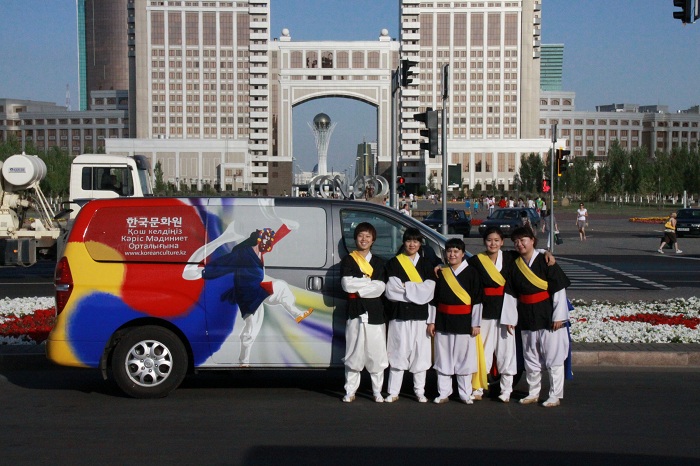Samarkand, the ancient Uzbek city, long ago straddled the main pathway for caravans traveling from east to west and from west to east. The city was a major point along the ancient Silk Road and also a meeting point for the peoples of both the East and the West to exchange political views, to do business and to develop the arts. The city was tied in sisterhood with Silla (57 B.C.- AD 935), the ancient first-millennium kingdom of Korea, and there are many other ties that link the two regions together.
In 1965, a wall painting was discovered in the Afrasiab Palace in Samarkand. In the middle of the painting were two figures wearing hats with feathers and carrying swords with round pommels. The artistic work is believed to be of two ambassadors dispatched from the Goguryeo Kingdom (37 B.C. - AD 668) during the 7th century. Most historians agree that Goguryeo had to send ambassadors to Samarkand in order to balance between the Tang Dynasty in China and the Silla Kingdom in southern Korea. They theorize that the Goguryeo must have felt the need to keep the Tang Dynasty in check, and hence sent the ambassadors. There is another view that specifically points to Yeon Gaesomun (603-666) as possibly being the figure who dispatched the ambassadors. Yeon was a powerful and controversial diplomat and generalissimo who had to fend off both the Tang and the Silla during the waning days of the Goguryeo Kingdom.
Since ancient times, the ancestors of modern Korea crossed the steppes and deserts of Eurasia and established diplomatic ties with the ancient kingdoms of Central Asia.
In fact, Tashkent, the Uzbek capital, has shared many things with Korean kingdoms of the past. The first Korean to establish roots in the region was the Goguryeo-Tang General Gao Xianzhi, presumed to have lived from 702 to 756 (고선지 or 高仙芝). It is known that some 1,200 years ago, General Gao crossed the Pamir Mountains and succeeded in conquering Seokguk, or 石國, the city which later became Tashkent.
In 751, General Gao and his Tang forces confronted the Abbasid Caliphate's army at the Talas River, which flowed through the borderlands between what is today Kyrgyzstan and Kazakhstan. During the battle, later called the Battle of Talas, the Tang Dynasty army led by General Gao was defeated by the Abbasid forces. However, it became a new opportunity as the paper millers, artisans and technicians captured by the caliphate handed over their skills to their captors, allowing paper-making technology to travel across Eurasia to the Mediterranean and to Europe.
Samarkand also has a special link with Korea, through Hyecho (혜초, or else 慧超 or 惠超) (704-787), a Buddhist monk and traveler from the Silla Kingdom. After travelling through the ancient lands of India, he complied the "Memoir of A Pilgrimage to Five Indian Kingdoms" (왕오천축국전 or 往五天竺國傳). In it, he provides a full account of his journeys to Kashmir, Afghanistan and parts of Central Asia.

In the 20th century, Central Asia established more ties with the Korean people. In the 1930s, amidst Stalin's series of huge-scale deportations, many ethnic Koreans were forced to leave the Soviet Far East and were forcibly settled in Central Asia. A great number of Koreans suffered in poverty and disease. Nonetheless, those who survived successfully accustomed themselves to their new climate and environment. The survivors showed persistence, diligence and even made the most of their farming skills to make a living. Their efforts, put into the cultivation of rice, vegetables, fruits and other foodstuffs that were rarely available, created the foundation for the establishment of a Korean community across the region.
As can be seen from the above, the peoples of Central Asia have maintained a strong and fruitful relationship with Korea since the ancient times and through to today.
Starting June 16, President Park Geun-hye will visit three countries in the region: Uzbekistan, Kazakhstan and Turkmenistan. With such strong ties from the past, it actually may now seem feasible that in the not-too-distant future there will be a Trans-Korea Railway (TKR), crossing Central Asia and Europe via North Korea, that will link the two sides of the Eurasian continent.
By Wi Tack-whan, Lee Seung-ah
Korea.net Staff Writers
whan23@korea.kr
In 1965, a wall painting was discovered in the Afrasiab Palace in Samarkand. In the middle of the painting were two figures wearing hats with feathers and carrying swords with round pommels. The artistic work is believed to be of two ambassadors dispatched from the Goguryeo Kingdom (37 B.C. - AD 668) during the 7th century. Most historians agree that Goguryeo had to send ambassadors to Samarkand in order to balance between the Tang Dynasty in China and the Silla Kingdom in southern Korea. They theorize that the Goguryeo must have felt the need to keep the Tang Dynasty in check, and hence sent the ambassadors. There is another view that specifically points to Yeon Gaesomun (603-666) as possibly being the figure who dispatched the ambassadors. Yeon was a powerful and controversial diplomat and generalissimo who had to fend off both the Tang and the Silla during the waning days of the Goguryeo Kingdom.
Since ancient times, the ancestors of modern Korea crossed the steppes and deserts of Eurasia and established diplomatic ties with the ancient kingdoms of Central Asia.
In fact, Tashkent, the Uzbek capital, has shared many things with Korean kingdoms of the past. The first Korean to establish roots in the region was the Goguryeo-Tang General Gao Xianzhi, presumed to have lived from 702 to 756 (고선지 or 高仙芝). It is known that some 1,200 years ago, General Gao crossed the Pamir Mountains and succeeded in conquering Seokguk, or 石國, the city which later became Tashkent.
In 751, General Gao and his Tang forces confronted the Abbasid Caliphate's army at the Talas River, which flowed through the borderlands between what is today Kyrgyzstan and Kazakhstan. During the battle, later called the Battle of Talas, the Tang Dynasty army led by General Gao was defeated by the Abbasid forces. However, it became a new opportunity as the paper millers, artisans and technicians captured by the caliphate handed over their skills to their captors, allowing paper-making technology to travel across Eurasia to the Mediterranean and to Europe.
Samarkand also has a special link with Korea, through Hyecho (혜초, or else 慧超 or 惠超) (704-787), a Buddhist monk and traveler from the Silla Kingdom. After travelling through the ancient lands of India, he complied the "Memoir of A Pilgrimage to Five Indian Kingdoms" (왕오천축국전 or 往五天竺國傳). In it, he provides a full account of his journeys to Kashmir, Afghanistan and parts of Central Asia.

Korea and Central Asia have had many exchanges across a wide range of sectors. Pictured is a traditional Korean dance troupe performing at the Korean Cultural Center in Astana, Kazakhstan. (photo courtesy of the Korean Culture and Information Service)
In the 20th century, Central Asia established more ties with the Korean people. In the 1930s, amidst Stalin's series of huge-scale deportations, many ethnic Koreans were forced to leave the Soviet Far East and were forcibly settled in Central Asia. A great number of Koreans suffered in poverty and disease. Nonetheless, those who survived successfully accustomed themselves to their new climate and environment. The survivors showed persistence, diligence and even made the most of their farming skills to make a living. Their efforts, put into the cultivation of rice, vegetables, fruits and other foodstuffs that were rarely available, created the foundation for the establishment of a Korean community across the region.
As can be seen from the above, the peoples of Central Asia have maintained a strong and fruitful relationship with Korea since the ancient times and through to today.
Starting June 16, President Park Geun-hye will visit three countries in the region: Uzbekistan, Kazakhstan and Turkmenistan. With such strong ties from the past, it actually may now seem feasible that in the not-too-distant future there will be a Trans-Korea Railway (TKR), crossing Central Asia and Europe via North Korea, that will link the two sides of the Eurasian continent.
By Wi Tack-whan, Lee Seung-ah
Korea.net Staff Writers
whan23@korea.kr

